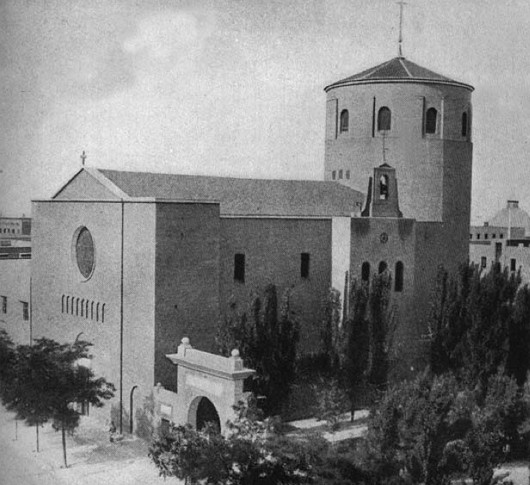
About Andrew Cusack
 Writer, web designer, etc.; born in New York; educated in Argentina, Scotland, and South Africa; now based in London.
Writer, web designer, etc.; born in New York; educated in Argentina, Scotland, and South Africa; now based in London. read more
News
Blogs
Reviews & Periodicals
Arts & Design
World
France
Mitteleuropa
Knickerbockers
Argentina
The Levant
Africa
Cape of Good Hope
Netherlands
Scandinavia
Québec
India
Muscovy
Germany
Academica
The Other Modern in Madrid
Miguel Fisac’s Church of Espíritu Santo, Madrid

It might be difficult for some to imagine that the architect of the pagoda-like Laboratorios Jorba outside Madrid was an accomplished classicist, but, like many modern architects, Miguel Fisac began his career with more traditional works. His very first commission as an individual was to design a church for Spain’s Consejo Superior de Investigaciones Científicas (Higher Council of Scientific Research). The CISC had only been founded in 1939 and was originally housed in existing structures around Madrid. The Church of the Holy Spirit (constructed 1942–1947) was the first newly built structure for the research council, and the fact that it was an ecclesiastic building “eloquently expresses the spirit of commitment between religion and science that animated the new project” (according to the Fundacion Fisac). Around the corner from the Church of the Holy Spirit, the main headquarters of the CISC was designed by Fisac.

The church was erected on the site of the auditorium of the adjacent Colegio Nacional Ramiro de Maeztu, and the architect incorporated the severe rationalist façade of the pre-existing structure into his plans for the chapel. Fisac also updated the building next door, which came to house the Goerres Hispano-German Library.


The style is an intriguing combination of a modern rationalist exterior informed by tradition with an interior in a highly (but skillfully) pared-down classical interior. Spain was not a rich country at the time, its destructive civil war having only ended a few years previous. As iron was expensive, the nave was topped in concrete vaultwork, and the bulk of the interior decoration is not architectural, but artistic: the nave and sanctuary paintings are by the painter Ramón Stolz.


While I admire the overall form of the building, the sanctuary is a disappointment. In the country that produced the extraordinary reredos of Toledo, Fisac’s altar here proves a dull and unexuberant design. Still, given the abominations of later ecclesiastical architeture, perhaps one should appreciate its sobriety. The red marble of the sanctuary at least contrasts with the grey of the nave, and appropriately draws the attention of the faithful to the altar where the mystery of the Eucharist is enacted.

Overall, however, Fisac’s Church of the Holy Spirit is a success. Simple, without being boring, it maintains an elegant respect for tradition while expressing a functional modernity appropriate for the age. A fitting example of “the other modern” in twentieth-century architecture.

Search
Instagram: @andcusack
Click here for my Instagram photos.Most Recent Posts
- Sag Harbor Cinema March 26, 2025
- Teutonic Takeover March 10, 2025
- Katalin Bánffy-Jelen, R.I.P. March 3, 2025
- Substack Cusackiensis March 3, 2025
- In the Courts of the Lord February 13, 2025
Most Recent Comments
Book Wishlist
Monthly Archives
Categories



What does the sanctuary look like now (2013)?
Andrew: this is a brilliant sanctuary, top lit, always flooded with light. Sapin has too many crowded sanctuaries: this one breaths. Arriba Espana!
It looks like the same.
The Opus Dei runs this church and Novus Ordo is neatly celebrated as they normally do.
My weeding ceremony took place there in 2003 and we pay this temple several visits a year.
I have never seen the patio shown in one of the photos.
A terracota statue of Saint M.Escriva in on the left hand side.
Yes, it is well maintaned, cross and six candelabra on the main altar, confessions all day long, good approach, “good battle” being fought there.
Dear Andrew
Not far from this church there is another “Other modern” example that could be of your interest. This is the church of San Agustín (Calle Joaquín Costa, number 10).
You can see a photograph of the exterior here:
http://www.parroquiasanagustin.es/
This is a Luis Moya work, so you may have studied it when you prepared that fab article about “La Universidad Laboral de Gijón” some 6 o 7 years ago.
Some other pictures and photos can also be found here.
informesdelaconstruccion.revistas.csic.es/index.php/…/article/…/890/1062
Thanks for your work..